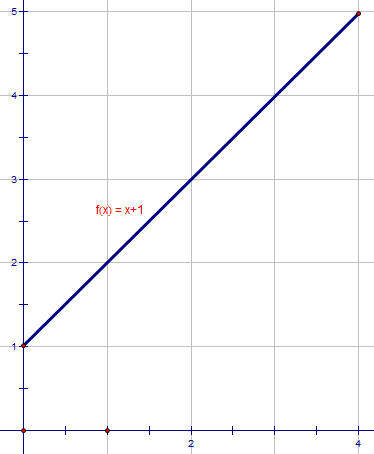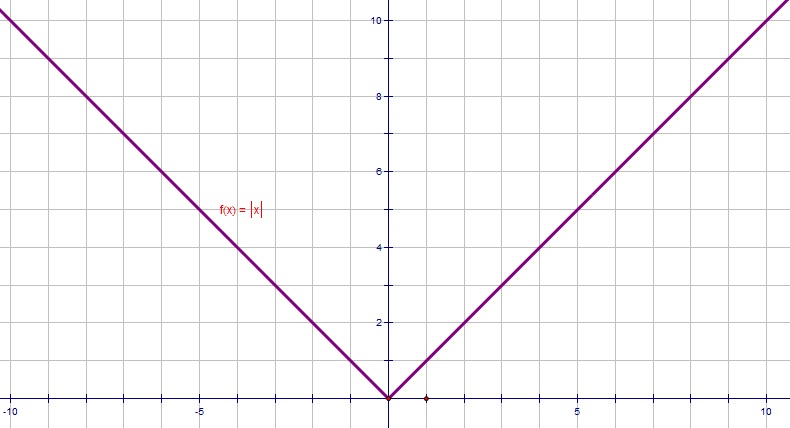C3: Algebra and Functions
Simplifying Expressions
Algebra works just like arithmetic. What works with numbers must also work with algebra because the letters in algebra stand for numbers.
I felt the need to point this out because I have seen so many ridiculous mistakes with algebra that would never happen with numbers.
Here's a couple of exam questions on this stuff.
Functions
Up until now we have used the word "function" without a really strong (rigorous) understanding of what it means.
In C3 we shall look at what "function" means. We will see that sometimes we will need to restrict what numbers we allow into our function (so that we don't divide by zero, for instance) and how to find the inverse function.
We will also meet a new (and very simple) function: the modulus function. We wil look at graphs of functions, including our new function, and transformations of functions.
Function Definition
At primary school you will have met the idea of a function machine. This might have been a (pretend) box that you feed numbers into and get a number out the other side. As a really simple example a "+1" function machine simply takes your number (say, 5) and adds one to give you a new number, the output (for an input of 5, the output would be 6).
In this course (and earlier) you will have used f(x) to define a function. For example:
f(x) = x2
By the way, another way of writing this is
f : x → x2, which is pronounced, "f maps x onto x2.
An input of 3 gives an output of 9 (32). We could write this in a much more "grown-up" way as:
f(3) = 9
Another example: suppose our function returned the reciprocal of the input. (remember that reciprocal means 1/x) I have already used "f" for the first function, so I'll call this one g(x).
g(x) = 1/x
And we could write g(2) = ½.
Now, what is g(0)?
Domain and Range
In the above example we stop the function from blowing up (dividing by zero) by banning the user of our function from using zero as an input.
We write this as part of our function definition like this:
g(x) = 1/x, x ∈ ℜ, x ≠ 0
This is read as "g of x equals one over x, where x is a real number but not zero"
That strange symbol (ℜ,) just means that x can be any real number (3, 0.5, -45, π, √2 etc.). In other words any number. (In FP1 you will meet other numbers called imaginary numbers but we don't need to worry about those here). The bit which says "x ≠ 0" just makes it clear that zero is banned from our function.
Here is the square-root function.
h(x) = √x
I have allowed any number to be input into it. Can you spot the problem that this makes?
I have now written the full definition of the square root function to avoid any errors:
h(x) = √x, x ∈ ℜ, x ≥ 0.
That should guarantee that no negative numbers get in to our machine causing problems.
In the h(x) function definition we banned negative numbers. But why stop there? It's our function, so we can decide what to allow in. We could make sure that only numbers between 3 and 6 are allowed in like this:
h(x) = √x, x ∈ ℜ, 3 < x < 6.
The numbers that are allowed in to our function are called the domain of the function. Usually the domain of a function is all real numbers but sometimes we must ban certain inputs (to avoid breaking math laws like division by zero or square-rooting negatives) and sometimes we ban some inputs for other reasons (such as we are only interested in certain input-output pairs.)
Look back at our f(x) function (I have added the domain):
f(x) = x2, x ∈ ℜ
What number went in if the output was 9?
The input must've been either -3 or +3 as both (-3)2 and 32 are equal to 9.
What number must've gone in if the output was -4?
Hopefully you see that the f(x) function only outputs certain values. In fact we can get any non-negative number out.
We could say this much more clearly:
f(x) = x2, x ∈ ℜ
⇒ f(x) ≥ 0
This last line tells us what values can possibly be output by the function. These values are called the range of the function.
So the domain is all the values allowed in and the range is all the values we can get out.
Here's a function I ahve just invented. See if you can tell what the domain and range are for my function.
k(x) = x + 1, x ∈ ℜ, 0 ≤ x ≤ 4.

Here is a graph of my function. Notice that no x values exist below zero or above four because I have banned them. The x values that are allowed are called the domain.
The y-values on the graph go from 1 to 5. This is the range.
So the x-values are the domain and the y-values are the range.
Inverse Functions
If a function maps x to f(x), then the inverse function gets you back to x again.
eg. These are inverse functions
f : x → x + 1
f -1: x → x - 1.
because if you feed 9 into f, you get 10. Feeding 10 into f -1 gets you back to 9. Try it with other numbers.
Here are some other functions and their inverses.
| Function f (x) | Inverse Function f -1(x) |
|---|---|
| x + 6 | x - 6 |
| 6x | x/6 |
| 2x + 1 | ½ (x - 1) |
| ¼x + 2 | 4(x - 2) |
And now for a guessing game...
I am thinking of a number. I feed my number into the function f : x → x2 and my answer is 4.
Can you guess my number?
Are you absolutely certain?
Functions like this can't have an inverse because there is no way of being certain that we get back to the original number.
A function that has only one possible answer for each question and only one question for each answer is called a one-to-one function
You are now sat there saying to yourself, "what is he on about? Of course there's an inverse of x2 and it's √x." Well not according to what I've just said.
For f (x = x2 to have an inverse we need to make sure that we don't get the same output for two different inputs. How can we do this?
If it exists, it's quite easy to figure out the inverse of a function. Simply think of your function as x = f (y) and make y the subject as in this example
eg Find the inverse of the following function.
f : x → x2 - 10, x ∈ ℜ, x ≥ 0
Answer
Let x = y2 - 10.
Re-arranging gives y = √(x + 10)
The possible outputs of f (x) (the RANGE) become the inputs of the inverse function (its DOMAIN). So the domain of the inverse is all numbers ≥ -10 since any number from -10 upwards can be outputted from our function. The inverse function is therefore:
f -1: x → √(x + 10), x ∈ ℜ, x ≥ -10
I attempt to explain this in the following clip...
The Modulus Function
We already know some easy functions from ages ago: x + 4, x ÷ 8. Later we learned so trickier ones: x2, √x. Then we met some even tougher functions: sin x, log x.
Well, now it's time for a new one. The modulus function. This function is in the easy catagory - all it does is make the input non-negative by simply ignoring the minus sign if there is one, or doing nothing if there isn't.
And that's it.
The modulus function is written |x|
We could add a domain to our function definition:
f(x) = |x|, x ∈ ℜ
And so f(3) = 3, f(66) = 66, f(-36) = 36, f(-356) = 356, f(0) = 0 etc.
Can you figure out the range of f(x)?
Here's a graph of the modulus function.

Hopefully you can see that x (domain) can take any value, whilst y (range) is never negative.
